
- C Programming Tutorial
- C - Home
- C - Overview
- C - Features
- C - History
- C - Environment Setup
- C - Program Structure
- C - Hello World
- C - Compilation Process
- C - Comments
- C - Tokens
- C - Keywords
- C - Identifiers
- C - User Input
- C - Basic Syntax
- C - Data Types
- C - Variables
- C - Integer Promotions
- C - Type Conversion
- C - Booleans
- C - Constants
- C - Literals
- C - Escape sequences
- C - Format Specifiers
- C - Storage Classes
- C - Operators
- C - Arithmetic Operators
- C - Relational Operators
- C - Logical Operators
- C - Bitwise Operators
- C - Assignment Operators
- C - Unary Operators
- C - Increment and Decrement Operators
- C - Ternary Operator
- C - sizeof Operator
- C - Operator Precedence
- C - Misc Operators
- C - Decision Making
- C - if statement
- C - if...else statement
- C - nested if statements
- C - switch statement
- C - nested switch statements
- C - Loops
- C - While loop
- C - For loop
- C - Do...while loop
- C - Nested loop
- C - Infinite loop
- C - Break Statement
- C - Continue Statement
- C - goto Statement
- C - Functions
- C - Main Functions
- C - Function call by Value
- C - Function call by reference
- C - Nested Functions
- C - Variadic Functions
- C - User-Defined Functions
- C - Callback Function
- C - Return Statement
- C - Recursion
- C - Scope Rules
- C - Static Variables
- C - Global Variables
- C - Arrays
- C - Properties of Array
- C - Multi-Dimensional Arrays
- C - Passing Arrays to Function
- C - Return Array from Function
- C - Variable Length Arrays
- C - Pointers
- C - Pointers and Arrays
- C - Applications of Pointers
- C - Pointer Arithmetics
- C - Array of Pointers
- C - Pointer to Pointer
- C - Passing Pointers to Functions
- C - Return Pointer from Functions
- C - Function Pointers
- C - Pointer to an Array
- C - Pointers to Structures
- C - Chain of Pointers
- C - Pointer vs Array
- C - Character Pointers and Functions
- C - NULL Pointer
- C - void Pointer
- C - Dangling Pointers
- C - Dereference Pointer
- C - Near, Far and Huge Pointers
- C - Initialization of Pointer Arrays
- C - Pointers vs. Multi-dimensional Arrays
- C - Strings
- C - Array of Strings
- C - Special Characters
- C - Structures
- C - Structures and Functions
- C - Arrays of Structures
- C - Self-Referential Structures
- C - Lookup Tables
- C - Dot (.) Operator
- C - Enumeration (or enum)
- C - Nested Structures
- C - Structure Padding and Packing
- C - Anonymous Structure and Union
- C - Unions
- C - Bit Fields
- C - Typedef
- C - Input & Output
- C - File I/O
- C - Preprocessors
- C - Header Files
- C - Type Casting
- C - Error Handling
- C - Variable Arguments
- C - Memory Management
- C - Command Line Arguments
- C Programming Resources
- C - Questions & Answers
- C - Quick Guide
- C - Useful Resources
- C - Discussion
C - Decision Making
Every programming language including C has decision-making statements to support conditional logic. C has a number of alternatives to add decision-making in the code.
Any process is a combination of three types of logic −
- Sequential logic
- Decision or branching
- Repetition or iteration
A computer program is sequential in nature and runs from top to bottom by default. The decision-making statements in C provide an alternative line of execution. You can ask a group of statements to be repeatedly executed till a condition is satisfied.
The decision-making structures control the program flow based on conditions. They are important tools for designing complex algorithms.
We use the following keywords and operators in the decision-making statements of a C program − if, else, switch, case, default, goto, the ?: operator, break, and continue statements.
In programming, we come across situations when we need to make some decisions. Based on these decisions, we decide what should we do next. Similar situations arise in algorithms too where we need to make some decisions and based on these decisions, we will execute the next block of code.
The next instruction depends on a Boolean expression, whether the condition is determined to be True or False. C programming language assumes any non-zero and non-null values as True, and if it is either zero or null, then it is assumed as a False value.
C programming language provides the following types of decision making statements.
| Sr.No. | Statement & Description |
|---|---|
| 1 | if statement An if statement consists of a boolean expression followed by one or more statements. |
| 2 | if...else statement An if statement can be followed by an optional else statement, which executes when the Boolean expression is false. |
| 3 | nested if statements You can use one if or else-if statement inside another if or else-if statement(s). |
| 4 | switch statement A switch statement allows a variable to be tested for equality against a list of values. |
| 5 | nested switch statements You can use one switch statement inside another switch statement(s). |
If Statement in C Programming
The if statement is used for deciding between two paths based on a True or False outcome. It is represented by the following flowchart −
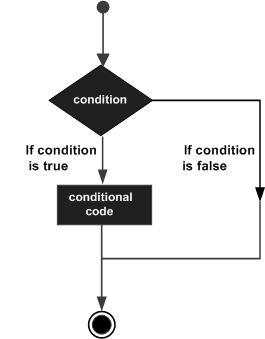
Syntax
if (Boolean expr){
expression;
. . .
}
An if statement consists of a boolean expression followed by one or more statements.
If...else Statement in C Programming
The if–else statement offers an alternative path when the condition isn't met.
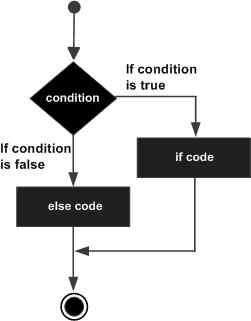
Syntax
if (Boolean expr){
expression;
. . .
}
else{
expression;
. . .
}
An if statement can be followed by an optional else statement, which executes when the Boolean expression is false.
Nested If Statements in C Programming
Nested if statements are required to build intricate decision trees, evaluating multiple nested conditions for nuanced program flow.
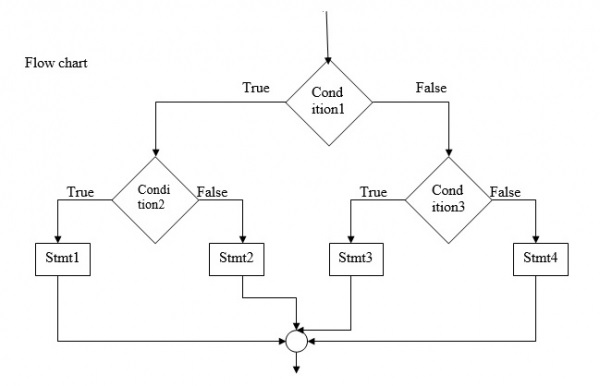
You can use one if or else-if statement inside another if or else-if statement(s).
Switch Statement in C Programming
A switch statement simplifies multi-way choices by evaluating a single variable against multiple values, executing specific code based on the match. It allows a variable to be tested for equality against a list of values.
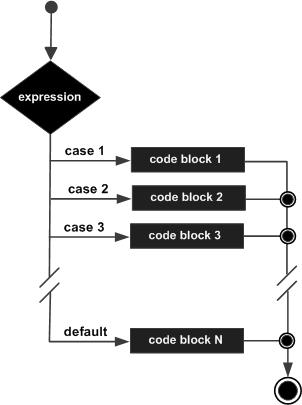
Syntax
switch(expression) {
case constant-expression :
statement(s);
break; /* optional */
case constant-expression :
statement(s);
break; /* optional */
/* you can have any number of case statements */
default : /* Optional */
statement(s);
}
As in if statements, you can use one switch statement inside another switch statement(s).
The ?: Operator in C Programming
We have covered the conditional operator (?:) in the previous chapter which can be used to replace if-else statements. It condenses an if-else statement into a single expression, offering compact and readable code.
It has the following general form −
Exp1 ? Exp2 : Exp3;
Where Exp1, Exp2, and Exp3 are expressions. Notice the use and placement of the colon (:). The value of a "?" expression is determined like this −
Exp1 is evaluated. If it is true, then Exp2 is evaluated and becomes the value of the entire ? expression.
If Exp1 is false, then Exp3 is evaluated and its value becomes the value of the : expression.
You can simulate nested if statements with the ? operator. You can use another ternary operator in true and/or false operand of an existing ? operator.
An algorithm can also have an iteration logic. In C, the while, do–while and for statements are provided to form loops.
The loop formed by while and do–while are conditional loops, whereas the for statement forms a counted loop.
The loops are also controlled by the Boolean expressions. The C compiler decides whether the looping block is to be repeated again, based on a condition.
The program flow in a loop is also controlled by different jumping statements. The break and continue keywords cause the loop to terminate or perform the next iteration.
The Break Statement in C Programming
In C, the break statement is used in switch–case constructs as well as in loops. When used inside a loop, it causes the repetition to be abandoned.
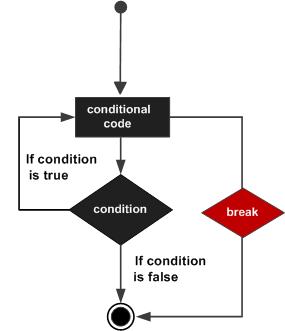
The Continue Statement in C Programming
In C, the continue statement causes the conditional test and increment portions of the loop to execute.
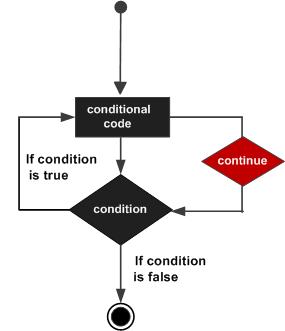
The goto Statement in C Programming
C also has a goto keyword. You can redirect the program flow to any labelled instruction in the program.
Here is the syntax of the goto statement in C −
goto label; .. . label: statement;
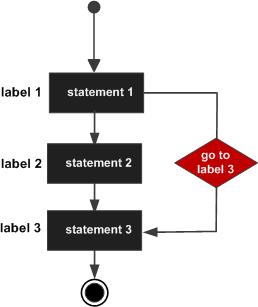
With the goto statement, the flow can be directed to any previous step or any subsequent step.
In this chapter, we had a brief overview of the decision-making statements in C. In the subsequent chapters, we will have an elaborate explanation on each of these decision-making statements, with suitable examples.

To Continue Learning Please Login